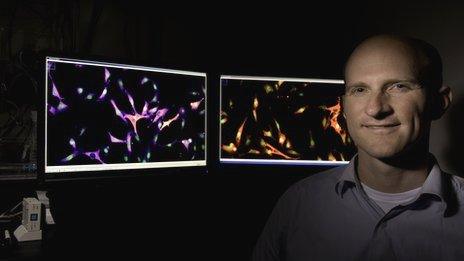The virtual cell that simulates life
- Published

Computer viruses are old news, but virtual bacteria might just be the future of biology.
Because on processors at Stanford University a simulation of the entire bacterium Mycoplasma genitalium, its DNA, and the constituents of its single cell is allowing biologists to tease apart the way life works.
"The public hear about a new 'cancer gene' being discovered, or a new 'Alzheimer's gene'. You hear about these all the time and you might wonder, with all these discoveries, where are the cures to those complex diseases?," explains co-author Prof Markus Covert, speaking to BBC Radio 4's Material World.
"The answer is that cancer is not a one-gene problem. There are thousands of factors interacting in very complicated ways and for us to understand a disease like that, we really need to start going back and trying to see if we can understand the whole cell," continues Prof Covert.
It was the complexity of the cell, the drive to understand how DNA leads to interactions with other molecules, and gaining the ability to explain how things can go wrong, that led the Stanford researchers to recreate M. genitalium's whole life-cycle digitally.
"We've done a lot at the single gene level, but if we really want to take discovery to the next level, we're going to need to consider systems: biological networks and pathways, and to do that we need a computational framework."
Prof Covert and his colleagues have been experimenting with live M. genitalium bacteria for many years, but the simulation they have developed now allows them to see whether their virtual bacterium behaves in the same way as the living organisms, highlighting where gaps in the understanding of biological processes lie.
"When we see something wrong, it's basically pointing us to those little nooks and crannies that we don't really understand," Prof Covert said.
A model's model
Although the team is keen to simulate more complicated systems, M. genitalium was chosen as its genome is small, being contained within a single chromosome, rather than for more aesthetic reasons: the bacterium is a sexually transmitted parasite.
Whereas the genetic code of a human cell contains over three billion "base pairs" - the letters of the genetic code - the bacterium has a genome of just over half a million.
The small size of its genome has previously led to the parasite being used as a "model organism" for experimenting how small a genome can be to support life.
"Model organisms can be used to learn almost universal mechanisms for how nature has solved problems," as explains Dr Birgitta Olofsson of Cambridge University, who uses the simple soil nematode worm Caenorhabditis elegans to investigate animal behaviour.
"At the very least, model organisms can tell you how nature solved problems in that specific organisms."
Model organisms are widely used in biology, explained Dr Birgitta Olofsson of Cambridge University, who uses the simple worm Caenorhabditis elegans to investigate animal behaviour.
However, virtually recreating a model organism and simulating the myriad functional complexities of even M. genitalium's simple life-cycle required enormous computing power.
"Each simulation, which is just one individual cell, holds around half a gigabyte (GB) of data. If you compare that to the information that's in the DNA which is about as big as a JPEG, there's a massive difference," Prof Covert says.
Programmable cell
In order to programme the entire cellular system, the researchers encoded data on the bacterium's biology from over 900 scientific papers and enlisted the help of one of Covert's good friends, Jared Jacobs, who had previously worked for Google.
"He came and worked for us for a few months and really revolutionised how we looked at the code. In particular he pushed us towards an 'object-orientated approach'," Prof Covert says.
This approach allows the program to isolate the functions of a cell into individual "modules" that interact with each other.
Within the cell, the DNA packed into a single chromosome behaves according to particular rules, but so do the amino acids the DNA codes for.
As these fold up into entire protein molecules, their interactions become highly complex - a phenomenon which biologists still do not fully understand.
Prof Covert and his colleagues hope that the simulation, which has been published in the journal Cell , and which the authors are keen to allow anyone to download, could assist biologists by being the equivalent of the computer-aided design tools used in other disciplines such as engineering.
The team has already shown in their research that they can predict outputs of certain experiments on the living organisms. This ability to predict, for instance, the movement of molecules within the cell, could lead to a breakthrough in using bacteria as "tools" whilst making sure the "designs" are safe and do not have unwanted side-effects.
"Bacteria are key suppliers of antibiotics, they are on the front line when we try to clean up an oil spill or bioremediation, and they're being used more and more to produce biofuels," Markus Covert explains.
"If you have a model of a process and you use it to guide your experiments, you'll discover things more quickly than you would without a model… Our model could actually accelerate the discovery process."
Prof Markus Covert was interviewed on Material World, first broadcast on Thursday 26 June on Radio 4 and is available on the iPlayer.
- Published13 June 2012
- Published23 July 2012
- Published20 May 2010